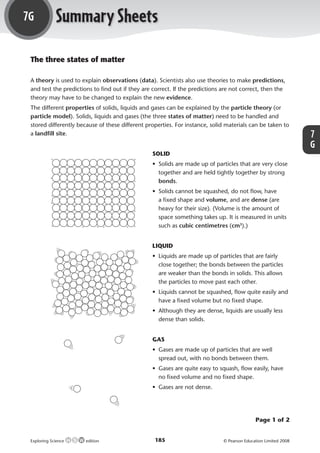More Related Content
Similar to Solids, liquids, gases
Similar to Solids, liquids, gases (14)
More from themassmaker (20)
Solids, liquids, gases
- 1. 7G Summary Sheets
The three states of matter
A theory is used to explain observations (data). Scientists also use theories to make predictions,
and test the predictions to find out if they are correct. If the predictions are not correct, then the
theory may have to be changed to explain the new evidence.
The different properties of solids, liquids and gases can be explained by the particle theory (or
particle model). Solids, liquids and gases (the three states of matter) need to be handled and
stored differently because of these different properties. For instance, solid materials can be taken to
a landfill site. 7
G
SOLID
• Solids are made up of particles that are very close
together and are held tightly together by strong
bonds.
• Solids cannot be squashed, do not flow, have
a fixed shape and volume, and are dense (are
heavy for their size). (Volume is the amount of
space something takes up. It is measured in units
such as cubic centimetres (cm3).)
LIQUID
• Liquids are made up of particles that are fairly
close together; the bonds between the particles
are weaker than the bonds in solids. This allows
the particles to move past each other.
• Liquids cannot be squashed, flow quite easily and
have a fixed volume but no fixed shape.
• Although they are dense, liquids are usually less
dense than solids.
GAS
• Gases are made up of particles that are well
spread out, with no bonds between them.
• Gases are quite easy to squash, flow easily, have
no fixed volume and no fixed shape.
• Gases are not dense.
Page 1 of 2
Exploring Science edition 185 © Pearson Education Limited 2008
M07_ES_AB_Y7_2445_U7G.indd 185 29/2/08 14:57:46
- 2. 7G Summary Sheets (continued)
Diffusion
The natural mixing of substances is called diffusion. Diffusion occurs because particles in a
substance are always moving around. Diffusion is fastest in gases, and slower in liquids.
Dilution
When you add water to orange squash you dilute it. The colour becomes paler because the
orange coloured squash particles are spread out more by the water particles.
7 Pressure in gases
G Pressure is caused by particles hitting the walls of the container they are in. The pressure may
increase because:
• the container has been squashed, making the volume smaller; this means that the particles will
be hitting the walls more often.
• the number of particles has been increased, which means there are more particles moving
around to hit the walls.
• the temperature of the particles has increased, so they will move around faster and hit the walls
harder and more often.
If the particles are in a flexible container, like a balloon, an increase in pressure will make the
volume increase. If the pressure becomes too great the balloon will burst.
Air pressure is the pressure caused by air particles around us. Air pressure lets us suck things up
using a straw and also causes a container to collapse if the air is sucked out. If all the air is sucked
out of a container, you get a vacuum – nothingness.
Page 2 of 2
Exploring Science edition 186 © Pearson Education Limited 2008
M07_ES_AB_Y7_2445_U7G.indd 186 29/2/08 14:57:47
